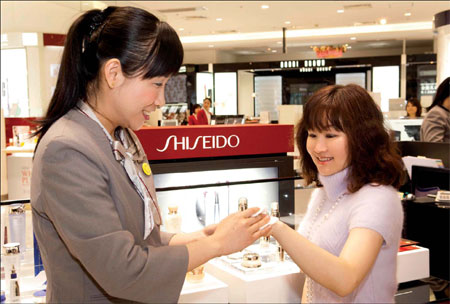Brushing off a slump
Updated: 2012-11-23 09:08
By Yao Jing (China Daily)
|
|||||||||||

|
Top: Shiseido has maintained annual double-digit sales growth in China since 2004. Above: A tailored beauty service for members of the high-end brand Cle de Peau Beaute of Shiseido. Photos Provided to China Daily |
It is said cosmetics buck the trend in economic slumps. Is it why cosmetics sellers in China are smiling?
You don't need a crystal ball or the musings of an industry analyst to see that the 13-percent drop in imports of cosmetics in China for the first half of this year was probably a blip. True, the volume of imports for cosmetics dropped heavily compared with the same period last year, according to the China Luxury Report 2012. But retail sales of cosmetics in China rose 16.5 percent in the first 10 months of the year, totaling 107.7 billion yuan ($17.28 billion; 13.44 billion euros) in sales, compared with the same period last year, the National Bureau of Statistics says. "The market is still growing, but just at a slower pace than in previous years," says Wang Jiajun, an analyst with China Market Research Group of Shanghai.
But the strongest indications that China's cosmetics industry is coasting are the massive expansion plans by international companies such as Estee Lauder Companies Inc and Mary Kay Inc of the US and Shiseido Group of Japan. Each of them is making bigger investments and attempting to pave wider and more numerous paths in a country where each is already highly recognized.
There are more than 5,000 cosmetics companies in China, 90 percent of them are small or medium-size domestic brands. However, international brands have more than 80 percent of the market share, according to Global Entrepreneur, a business magazine in China. Multinationals offer more brands and products across a range of categories and prices, says Beauty and Personal Care in China 2012, a report by Euromonitor International Ltd.
Estee Lauder, which sells a dozen of its 28 cosmetic brands in China, is arguably making the biggest splash among the multinationals. It is doing what many companies rarely attempt: introducing an entirely new brand.
Known for its Estee Lauder, Clinique and Bobby Brown brands, in October the company introduced a new line called Osiao (pronounced O-Shao) that specifically caters to Chinese consumers.
Based in New York, Osiao was launched in Hong Kong last month and is not expected to arrive in the Chinese mainland until early 2014.
"China has become the company's third largest market following the (United States) and (Britain) with a turnover of $500 million in the fiscal year of 2012 that ended June 30," says Fabrice Weber, president of Estee Lauder's Asia-Pacific division, in an interview this month with 21st Century Business Herald.
|
||||
"European and US brands are very strong in the higher-end market as they are viewed as having superior technology, such as anti-aging creams and quality," Wang says, "consumers trust these brands a lot more and are willing to pay high premiums for them."
One of the mainland's cosmetics mainstays, Shiseido, which has been operating in China for 31 years, is aiming to take domestic sales revenue above 100 billion yen by early next year. The first overseas cosmetics maker to the market, it sells a wide range of products ranging in price from dozens of yuan to nearly 5,000 yuan for a diversity of consumers.
Late last year, Shiseido began to sell its Pure&Mild brand products online. Early this year it began selling its products on Tmall.com. Its competitor, the online sales of Estee Lauder grew by 40 percent in China in the fourth quarter of fiscal year 2012. It is reaching online consumers in nearly 350 Chinese cities.
"Even though the online channel only accounts for a small percentage of sales, it is growing the fastest of all," Wang says. "Brands need to have a strong online store, either self-operated or through e-retailers as Tmall and 360buy."
In keeping up with market trends, Shiseido has maintained annual double-digit sales growth in China since 2004. Sales reached 89.1 billion yen for the year that ended on March 31.
"China now accounts for more than 10 percent of our global business," says Yang Yan, general manager of the public relations department at Shiseido China Co Ltd.
Today's Top News
Rescuers race against time for quake victims
Telecom workers restore links
Coal mine blast kills 18 in Jilin
Intl scholarship puts China on the map
More bird flu patients discharged
Gold loses sheen, but still a safe bet
US 'turns blind eye to human rights'
Telecom workers restore links
Hot Topics
Lunar probe , China growth forecasts, Emission rules get tougher, China seen through 'colored lens', International board,
Editor's Picks

|

|

|

|

|

|








